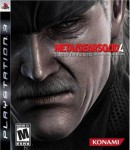$20 Game of the Week: Metal Gear Solid 4 (PS3)
by William Talley, filed in $20 Game Of The Week, Games on Jul.19, 2010
 Hideo Kojima’s masterpiece is most likely the reason you bought a PS3, and for good reason. Like its predecessors, Metal Gear Solid 4 bends the rules of video game convention to become a landmark for its generation of gaming, and like its predecessors, it deserves a space on your shelf.
Hideo Kojima’s masterpiece is most likely the reason you bought a PS3, and for good reason. Like its predecessors, Metal Gear Solid 4 bends the rules of video game convention to become a landmark for its generation of gaming, and like its predecessors, it deserves a space on your shelf.
Taking place a few years after MGS2, MGS4 once again puts players in the role of Solid Snake. However, he is much older this time out, due to cloning degeneration, and this could very well be his last mission. In the world of MGS4, war is no longer what it used to be. Instead of one nation’s army versus another nation’s army, it’s now Private Military Corporations (read: mercenaries) vs small resistance groups or other PMCs. The biggest PMC runs on a network of nanomachines known as SOP, and Liquid Ocelot, the amalgamation of Liquid Snake and Revolver Ocelot, is in control of it all. It’s up to Snake to bring the whole system down.
MGS4 is like one of those TV series finales or one of those comic book anniversary issues where everybody who was ever part of the series shows up. Any question you’ve ever had about the series will be answered by the end of the game. What happened to Meryl? What happened to Naomi? Did they find Olga’s daughter? Does Snake really have the Foxdie virus? How do the events of MGS3 factor into things? MGS4 contains many nods to past entries in the series.
The gameplay is classic MGS, although there have been several new techniques added. The camoflauge system of MGS3 has been replaced with a camosuit which can blend into the terrain, you can earn money to buy weapons from your new ally Drebin, and there is a first person perspective you can play the game in if you want. Throughout the first half of the game, you’ll be making your way through battlefields where rebel forces are battling forces of the PMCs. You can involve yourself in these conflicts and get the rebels on your side, of you can use the war as unseen cover. You never find out which part of the particular region that you are in, who is fighting who, or why they are fighting, but that isn’t important. You can see an underlying message about war, and this may even be a commentary on the Blackwater scandal which had gone on months prior. Although Hideo Kojima didn’t say so, he didn’t deny it either. All these things are here to help players approach the game however they wish and be rewarded for it. Whether you want to stick to the series’ trademark stealth action gameplay, take a run-and-gun approach, or make your way through the game without killing anyone, the game will allow you to take that path.
The game is divided into 5 chapters, each taking place in a different region of the world. Your main enemies are the Beauty and the Beast corps, which are women who have been mentally and emotionally scarred by war and have twisted themselves into robotic monsters. The battles against them are just as intense and memorable as the Foxhound leaders in MGS1, Dead Cell in MGS2, and The Boss’s children in MGS3. After you defeat them, you get to hear their disturbing stories.
There are two major issues that critics were very critical about. For one, the game goes into the install process automatically at the beginning of the game and after every chapter. This is something I blame more on Sony. Secondly, the cinemas tend to be lengthy. I don’t count this as much of a fault either, as the MGS games have always made use of long cinematics to tell the story, and you shouldn’t expect anything different from this one. Besides, the cinematics are awesome to watch, and they help move the story along.
Even with those two issues, MGS4 is another triumph for Konami. This makes an excellent send-off for Solid Snake even if the MGS series isn’t done yet (Konami has recently released Peacewalker for PSP and is working on MGS Rising for Xbox 360 and PS3). MGS4 represents everything that we love about the series, and it represents everything that we love about gaming period.


 PS3
PS3
 Famicom Dojo
Famicom Dojo KEEP PLAYING
KEEP PLAYING KEEP PLAYING: Rewind
KEEP PLAYING: Rewind Powet Toys
Powet Toys Powetcast
Powetcast Hitchhiker's Guide POWETcast
Hitchhiker's Guide POWETcast














